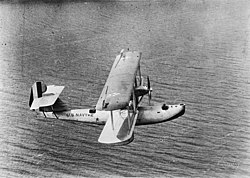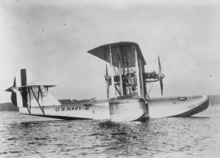Boeing PB
| Boeing PB | |
|---|---|

|
|
| Type: | Flying boat |
| Design country: | |
| Manufacturer: | |
| First flight: |
August 31, 1925 |
| Number of pieces: |
1 |
The Boeing PB (factory designation Model 50) was a double-decker - flying boat , which as a guide plane for two Naval Aircraft Factory PN-9 should be used, which in 1925 the first attempt at a non-stop flight between the California coast and Hawaii took. Only one copy of the PB was built.
history
Development of the Model 50 began in September 1924 in response to a request from the US Navy requesting a twin-engine long-haul flying boat that should be able to cover the 3800 km from San Francisco to Hawaii non-stop. The design, designated by the US Navy after the order was placed by the Naval Bureau of Aeronautics as the PB-1 , was essentially an enlarged further development of the Naval Aircraft Factory PN-7.
The PB-1 with the serial number 801 and the bureau number A6881 flew for the first time on August 31, 1925. Due to problems with the engines, however, it could not accompany the two PN-9s on the long-range test flight, which ultimately failed. The machine was then used by the NAF as a test vehicle and probably scrapped in 1932.
construction
With the exception of the two engines in tandem, the PB-1 was largely conventional. However, it already had some innovations in structural design that were also used in future Boeing developments. The wing spars were designed as a welded tubular framework and the wing ribs consisted of steel tubes and open steel profiles. The wing leading edges and the wing tips were wooden elements. The most unusual was the hull construction with a metal lower part and an upper part, which consisted of plywood frames planked with wood veneer.
The then new Clark Y- profile was used for the wings . The use of small auxiliary wings above the ailerons as aerodynamic rudder compensation was also new, instead of the usual mass compensation that was still used on the tail surfaces.
variants
- PB-1
- original configuration with two water-cooled 12-cylinder V-engines Packard 2A-2500 , each with an output of 800 hp. The PB-1 did not yet have the suffix "X", because the US Navy at that time did not yet differentiate between the prototype or test status and the series designation.
- XPB-2
- In 1928 the NAF replaced the Packard engines with two experimental Pratt & Whitney R-1860 Hornet radial engines equipped with reduction gears, each also producing 800 hp.
In 1945 the US Navy and the US Coast Guard also designated a single Boeing B-17F that they received from the Air Force as a Boeing PB-1. Another 48 machines of the type B-17G were listed as PB-1W and PB-1G.
Technical specifications
| Parameter | Data |
|---|---|
| crew | 5 |
| length | 18.01 m |
| span | 26.55 m |
| height | 6.35 m |
| Wing area | 169.4 m 2 |
| Top speed | 180 km / h |
| Range | 4000 km |
| Empty mass | 5240 kg |
| Takeoff mass | 12170 kg |
| drive | 2 × 12-cylinder V-engines Packard 2A-2500 with 800 HP each |
See also
literature
- Peter M. Bowers : Boeing Aircraft since 1916. Putnam, London 1966, reprint 1989, ISBN 0-85177-804-6 , pp. 73-75.
- ER Johnson: American Flying Boats and Amphibious Aircraft . McFarland and Co., 2009, ISBN 978-0-7864-3974-4 , pp. 24-26.
- Bill Yenne: The Story of the Boeing Company. Zenith Imprint, St. Paul 2005, ISBN 0-7603-2333-X , p. 15.
Web links
- Naval Aircraft Factory and Boeing PB-1 (PDF; 1.10 MB)
Individual evidence
- ↑ ER Johnson, 2009, p. 26.
